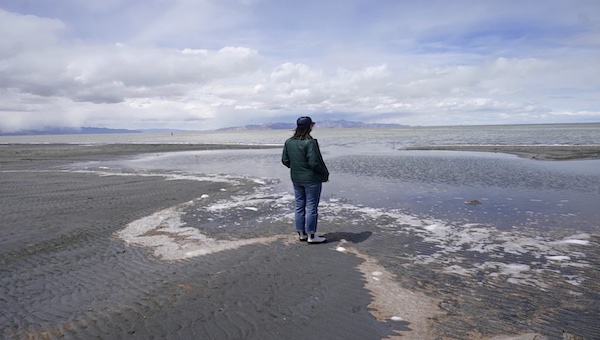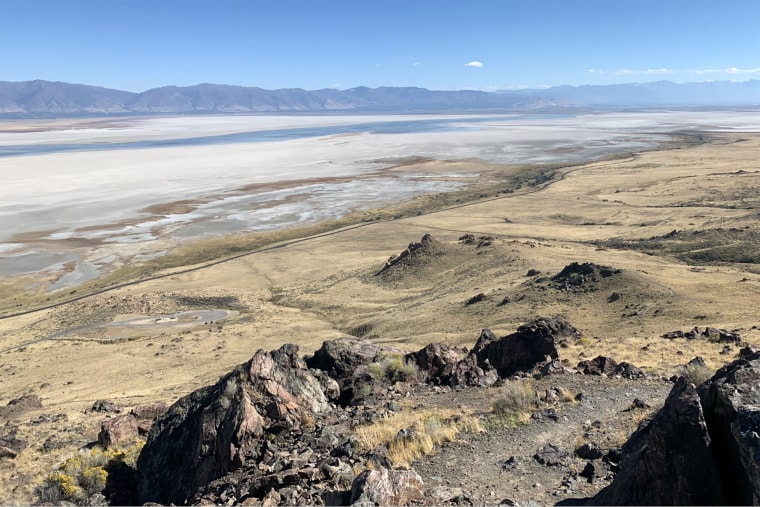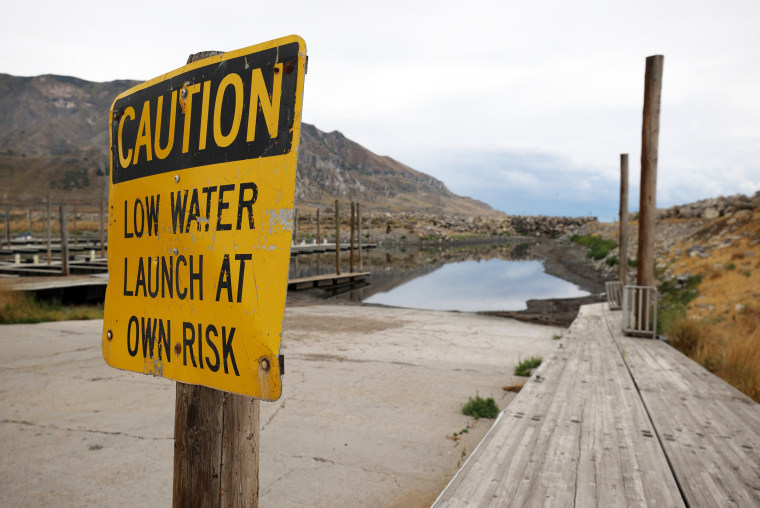
LT. GOV. DEIDRE HENDERSON WALKS ALONG THE GREAT SALT LAKE NEAR SALT LAKE CITY IN 2022
RICK BOWMER / POOL/AP FILE
WITH GREAT SALT LAKE AT ROCK BOTTOM, LAWMAKERS AIM FOR RESCUE
BY: EVAN BUSHORIGINAL SITE: NBC NEWS
TOPICS
Activism
AI
Belief
Big Pharma
Conspiracy
Cult
Culture
Economy
Education
Entertainment
Environment
Faith
Global
Government
Health
Hi Tech
Leadership
Politics
Prophecy
Science
Security
Social Climate
Universe
War
The shrinking Great Salt Lake is facing ecological collapse as salinity levels rise. State leaders hope a hearty snowpack and a surplus in the state budget can save the lake — or at least buy them time.
Utah lawmakers have mounted emergency rescue plans for the Great Salt Lake, which is on the verge of ecological collapse. Before the legislative session opened on Tuesday, scientists and conservationists issued the most dire warning yet over the lake’s future, saying “the lake as we know it is on track to disappear in five years” if losses continue at their recent pace.
The lake is shrinking, but even more urgent is its changing salinity. The lake has grown so salty that creatures at the base of its food web, such as brine flies, which have adapted to survive extreme conditions, are disappearing.
Still, the recipe is right for a comeback as state lawmakers begin their 45-day legislative session.
“We’re at a crossroads on the lake itself,” said Joel Ferry, the executive director of the state department of natural resources. “Are we willing to accept the lake is not going to be productive? That we’re going to have dust storms and an ecosystem not thriving and in collapse? We’re not willing to do that as a people and a state.”
State coffers are flush, with estimates projecting billions in unanticipated state revenue atop an existing $1.3 billion budget surplus. Lawmakers say they’re ready to open the financial floodgates. Public and media attention have centered on the lake, raising pressure for officials to act. And the mountains above Salt Lake City gleam with a snowpack that’s nearly double its typical size for this time of year and should provide a hearty flow of spring runoff to the rivers that feed the Great Salt Lake.
Decisions and investments made during the legislative session could set a new course for the lake, buy time to restore it and ultimately determine its fate, state political leaders say.

Exposed playa on the Great Salt Lake as seen from Antelope Island. The playa is a source of dust that could worsen air pollution.
Evan Bush / NBC News
Water volume on the Great Salt Lake has dropped by more than two-thirds since pioneers once settled the Salt Lake Valley. Much of the lake surface is now exposed. This fall, water levels fell to all-time lows.
Photographs of empty marinas and the cracking crust of the lake’s surface often illustrate the lake’s decline. But perhaps the most concerning symptom lies beneath the surface of what little water is left. The lake’s salinity levels have risen dramatically in recent years, nearing dangerous thresholds for the creatures at the base of its food web.
“As the lake goes down, water evaporates but salts are left behind,” said Wayne Wurtsbaugh, a professor emeritus of water sciences at Utah State University. “We’re getting to the level where high salinity is stressing organisms that are adapted to that environment — that’s mainly brine flies and brine shrimp.”
About 10 million migratory birds — some 338 species — depend on the lake’s habitat to survive.
“We could see nonlinear collapses of food webs, and that’s going to happen before the lake disappears,” said Ben Abbott, a Brigham Young University professor who led the scientific group that’s warned of an emergency.
Brine shrimp are a critical food source for the aquaculture industry. Low water levels threaten other economic staples, too. The lake’s decline pushed U.S. Magnesium, the country’s largest magnesium producer, to apply to extend canals that are used to take in and evaporate lake brine to mine the metal. The Utah Department of Environmental Quality denied its application late last year.
In the meantime, unhealthy dust from the lake’s dried surface — which contains arsenic and other heavy metals — blows into communities near the lake, threatening more than 2 million residents in a region already struggling with the quality of its air. .
State officials in recent years have awakened to the lake’s problem — that upstream water use strangles the terminal lake. The rivers and streams that feed The Great Salt Lake are overallocated, which means farmers and other water users collectively have rights to more water than what typically flows through each year. The amount of water that reaches the lake, particularly during a drought, is insufficient.
Last year, lawmakers passed several bills designed to reshape the state’s relationship with water. One bill created a water trust designed to benefit the lake and its wetlands. The Nature Conservancy and Audobon Society were designated to lead the trust , which received $40 million from the Legislature. Another bill makes it a “beneficial use” for farmers to allow water to flow to the lake . Previously, not using all of the allotted water risked losing future use of that water.
Separately, Utah Gov. Spencer Cox last November closed the Great Salt Lake basin to appropriations for new water uses , effectively capping the line of water users wanting to use what flows into the lake.
The recent report from scientists and conservationists says those measures are not enough, and that the impacts of those measures would take too long and that a concerted effort to rescue the lake was needed.
“The lake needs water this year,” Abbott said.
Lawmakers say they’re poised to shower the problem in new funding.
Last session, “we passed significant pieces of legislation that gave us the tools to help us save the lake,” said Casey Snider, a Republican state representative. “This session, we now have the option to pull funding levers.”
Cox, in his annual budget included $132.9 million for the lake, incorporating $100 million for short-term water leases to “shepherd” agricultural water to the lake, and another $217.9 million for statewide water conservation and supply measures.
“We will do more than that. I’m confident. Probably significantly more,” said Utah House Speaker Brad Wilson. “There’s probably no issue more important than investing in and supporting our water strategy for the lake.”

Wilson said lawmakers plan to provide more money for water optimization grants in agriculture, to increase funds to the water trust and to further study groundwater, among other measures.
The timing is auspicious.
Lawmakers have a nearly $1.3 billion budget surplus to work with. Recent revenue forecasts projected another $4 billion in unexpected revenue through the 2024 fiscal year, though only a portion of that money can be designated for the lake.
Also, there should be enough water for emergency rescue measures this spring and summer.
So far, Utah has received bountiful snow. The basins that primarily feed the Great Salt Lake all have snowpacks higher than 150% of what’s considered normal for this winter. The lake is up about a foot since its historic low in November.
Spending money to lease water rights and ensure that water reaches the lake could boost lake levels by a few feet overall, said Kevin Perry, a University of Utah atmospheric scientist.
“We can buy ourselves a couple years of breathing room,” Perry said.
